|
|
|
|
Book Reviews from the Staff of the Poison Pie Publishing House
|
|
December 21, 2019
Bestiaries of 2019
In the year 2019, the staff of the Poison Pie Publishing House continued their weekly update of A Survey of One Hundred Bestiaries. (The survey has now grown to over 280 entries, although its title has not been updated.) A number of these bestiaries were published in 2019, including
- Monsters and Creatures: A Young Adventurer's Guide (Wizards of the Coast) (282)
- Pathfinder Bestiary, 2nd Edition (Paizo) (283)
- Starfinder Alien Archive 3 (Paizo) (284)
- Rifts Bestiary Volume One (Palladium) (285)
- Numenéra: The Ninth World Bestiary 3 (Monte Cook Games) (286)
- The Untamed Beastiary: A Field Guide to Marvelous Monsters (Untamed Beasts) (287)
We enjoyed reading each of these bestiaries. No two books of beasts are ever quite alike. Each contribution brings with it a unique approach and new creatures. We recommend investigating all of them to the interested reader. The survey objectively presents publication information and a fragment of a single beast entry for each book. In this review, we offer a few additional, subjective thoughts.
|
|
|
|
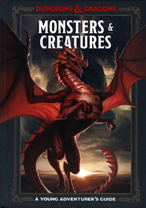 |
|
Monsters and Creatures: A Young Adventurer's Guide (Wizards of the Coast, 2019, 282)
|
There are a tremendous number of bestiaries associated with the Dungeons & Dragons role playing game, from Monsters and Treasure (TSR, 1974, entry #30) to Mordenkainen's Tome of Foes (Wizards of the Coast, 2018, entry #227). In between, every edition of the game has had a Monster Manual
(1st,
2nd,
3rd,
3.5th,
4th &
5th)
and some editions as many as five. Additionally, each edition has other bestiaries published under titles other than Monster Manual. Beginning with the 3.5th edition, it became common to distribute a smaller number of monsters in many books touching on a particular theme, where the bestiary constituted one chapter of the whole, rather than assembling a new book devoted entirely to monsters from various areas, a practice, which continues in the current edition. The Manual of the Planes (Wizards of the Coast, 2001, entry #86) is one example of many.
With this abundance of riches, it may seem difficult to justify another introductory bestiary, covering the most iconic creatures of D&D. However, the Monsters and Creatures: A Young Adventurer's Guide presents familiar creatures in a way that is targeted to young readers. We thoroughly enjoyed the light-hearted approach of author, Jim Zub, and the artwork as well. As a closing thought, we lament the fact that Wizards of the Coast, as a corporate property of Hasbro (HAS), dehumanizes artists and refuses to credit them in the book for their work.
|
|
|
|
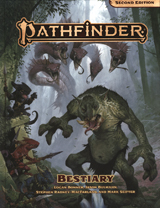 |
|
Pathfinder Bestiary, 2nd Edition (Paizo, 2019, 283)
|
The second edition of the Pathfinder Role-Playing Game was released in 2019. This book is one of the two core volumes for the new edition. As was the case with D&D, there were numerous bestiaries in the previous edition (six volumes explicitly titled as such:
1,
2,
3,
4,
5 &
6) along with many smaller releases devoted exclusively to beasts. See for example, Fey Revisited (Paizo, 2013, entry #54).
There was a span of time when it could be argued that Pathfinder pre-empted D&D as the world's most popular fantasy role playing game (RPG). In any case, it was certainly healthy for the community to have a source to new gaming material that was not dominated by a monopoly. Game play in the years around 2010 were very different if one was playing Pathfinder or 4th edition D&D. With advent of both 5th edition D&D and 2nd edition Pathfinder, there is now relatively little difference in the experience at the table. The advantage of D&D is that it has intellectual property rights to certain iconic creatures. In our opinion, there are two primary advantages to Paizo. First, the Paizo had a dedicated Pathfinder staff who dynamically engage with the community on a seemingly daily basis, addressing concerns as necessary. Second, the quality of the adventures produced by Paizo, typified by the monthly issues of the Pathfinder Adventure Path, far exceed the quality of the 5th edition D&D adventures. There are numerous reviews of the first 5th edition D&D adventure, The Rise of Tiamat (2014) that point out its dreadfully confusing organization and lackluster encounters. A more recent 5th edition D&D adventure, Waterdeep: Dungeon of the Mad Mage (2018) lacks adequate illustration and is generally regarded as a lazy, monotonous effort filled with empty rooms for adventurers to waste their time in as well as routinely, undefined passageways to be created by the DM. One doesn't see these sorts of disastrous errors in judgment and design in a Pathfinder adventure. (Issue 150 of the Pathfinder Adventure Path was recently released, so there is a significant body of evidence to make this case.)
The 2nd edition of Pathfinder doesn't appeal to us, relative to the 1st edition, because the new effort resembles too closely 5th edition D&D and homogeneity is bad for the hobby. However, we hope that Paizo succeeds in building a sustainable following for the 2nd edition so that RPG enthusiasts have a choice of two systems, both of which regularly release new products.
That said the 2nd edition Pathfinder Bestiary is a beautiful book of beasts. It is essentially a re-statement of core beasts with modified stat blocks compatible with the new rules, although a few new monsters have been added. However, all of the art is new. It possesses all the high production values of Pathfinder products. Each entry is lavishly illustrated and contains a reasonable amount of flavor text to accompany the statistic blocks. While Paizo no longer allows its contracted artists to have their names appear next to the images, they do at least provide a list of artists in the opening credits of the book.
|
|
|
|
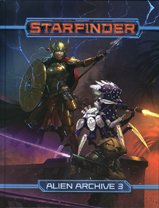 |
|
Starfinder Alien Archive 3 (Paizo, 2019, 284)
|
In last year's review of bestiaries released in 2018, we commented on the the second volume of the Starfinder Alien Archive. There we noted our dissatisfaction with the mechanical, cookie-cutter approach that has been adopted by the game designers for Starfinder, so we will not repeat ourselves here. Instead, we exclusively focus on the third volume of the Alien Archive series.
It is hard not to get the feeling that Starfinder is the neglected younger brother of Pathfinder in the Paizo household. There are too many entries in Alien Archive 3 that are best described with the adjective "space", as in space badgers, space walruses, space turtles, etc. As a comical effort, the book succeeds. The staff of the Poison Pie Publishing House sat on the sofa and laughed as each entry one-upped the previous one in terms of lack of originality. Still, some entries really caught our attention. We collectively chose the dromada to be high-lighted in the survey because it is an unholy amalgamation of Joe Camel, Scooby Doo & Jar Jar Binks! This is reason enough to be fond of a bestiary. Certainly, as we have investigated more than 280 bestiaries, we have discovered many books with unique, distinguishing features that are not especially complimentary. Starfinder Alien Archive 3 doesn't lead the pack in this regard. In truth, we enjoyed this bestiary. The high production quality of Paizo is present. Each entry has an illustration, flavor text and a statistics block. There are lots of examples of creatures that don't raise the eyebrows as much as a space turtle or the hapless dromada.
|
|
|
|
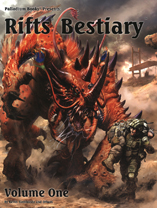 |
|
Rifts Bestiary Volume One (Palladium, 2019, 285)
|
Our entry into Palladium books began with Teenage Mutant Ninja Turtles in the 1980s. We have always wanted to include a TMNT bestiary in the survey, but amazingly there isn't such a book. In fact this bestiary is the first book by Palladium to be included in our survey. It is the first half of a planned two-volume set, arranged alphabetically by creature name. It appears there is an effort to relaunch the Rifts system underway in 2019. This book does not appear to be a reissue but it also doesn't claim to present new material. As such, it may be a compilation of material that appeared in previous books. The dates that appear in the artwork are from the 1990s. The creatures in the book are found exclusively on the North American continent of the Rifts post-apocalyptic setting. The demon beaver was selected as an example from this bestiary. The style of the artwork and the extract of text from the description of the beast are characteristic of the book as a whole.
|
|
|
|
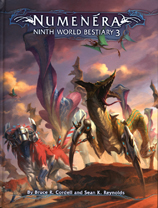 |
|
Numenéra: The Ninth World Bestiary 3 (Monte Cook Games, 2019, 286) |
Monte Cook has been involved in the development of many different roleplaying systems, including Planescape from 2nd edition D&D and the core rulebooks for 3rd edition. In 2012, he formed Monte Cook Games, which has created several different RPGs. This survey of bestiaries includes all three volumes of The Ninth World Bestiary series
(1 (2014);
2 (2017); &
3 (2019)) as well as The Strange Bestiary (2014).
To be honest, there are only so many hours in the day and we have never played either Numenéra nor The Strange. However, we do love the bestiaries produced for these games. As was the case with Planescape, Numenéra is a highly stylized campaign setting. The entries in the bestiary have been created to uniquely fit in that world, set a billion years in the future. There appears to be a conscious effort to limit the entries to creatures who maintain the feel of the Numenéra world. Many of the creatures blend organic and technological components, though others are purely xenomorphic in form. The bestiaries continue to improve with each volume. We recall in the first volume being surprised at how many times the phrase "hungers for flesh" was repeated as a creature's motivation. The distribution of motivations in volume three is much greater and does not strictly include a fixed list of formulaic phrases. In the survey, we selected a fragment of the description of the kodymir as a representative entry, though there were many other equally interesting creatures we could have chosen instead.
|
|
|
|
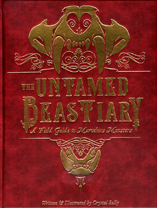 |
|
The Untamed Beastiary: A Field Guide to Marvelous Monsters (Untamed Beasts, 2019, 287) |
At the Poison Pie Publishing House, we freely admit a bias for independent, self-produced manifestations of individual creativity over mass-produced commercial products. Our guiding principle in this philosophy is given by the example of non-idiomatic improvisational musicians, who embrace a tradition and a set of aesthetics that eschews rehearsed performances and highly polished production values in favor of genuine in-the-moment expression. This preference for individual voices explicitly combats the tendency toward monoculture inevitable in corporations that have as a stated goal the optimization of shareholder value. While all of the RPGs described above began as individual visions, at least some of them no longer qualify for that description.
The Untamed Beastiary: A Field Guide to Marvelous Monsters, however, is an independently created, self-published, crowd-funded bestiary. The creative idiosyncrasies of the author/illustrator, Crystal Sully, are on full display. Ms. Sully's talents as an artist are put to good use in the illustrations for each entry in the bestiary. The graphic design of the book allows the illustrations to be presented in a way that places the reader in universe. Many of the creatures are unique to this book. Even with much-covered beasts like the werewolf, there is an attempt to give each creature individuality by including an additional sub-entry detailing a unique specimen. The pleasure of the author in having the opportunity to create this book is evident on every page. The reader can't help sharing in the author's ebullience.
More attention is given to the graphics side than the text side. Many of the descriptions are quite short and could have benefited from a bit of editing. However, we embrace a philosophy that allows us to see typographical errors in a self-published book as credentials of the independent artist.
The book was funded on Kickstarter, with an original delivery date of March, 2018. Our book arrived in December, 2019. A delay of twenty-one months is tolerable now that this excellent book is in hand, although as the prevalence of Kickstarter campaigns that never deliver the product seems to increase, the recurring poor estimation of the production timeline can be cause for irritation and anxiety. In this case, it appears much of the delay was due to the simultaneous creation of a deluxe version of the book, in which some of the illustrations contain skeletons, which only become visible under ultraviolet light. We opted not to purchase the deluxe version for two reasons. First, the aforementioned lack of accountability on Kickstarter discourages bigger investments. Second, our interest in the book is at least partially archival, in terms of our on-going survey of bestiaries. It remains unclear how the UV-active ink will impact the illustrations as the book ages.
Digressions aside, of the six bestiaries released in 2019 which we have high-lighted in this review, this is the most independent effort by far. If you were to purchase only one bestiary in 2019, The Untamed Beastiary should be the one. If you splurge for two, Numenéra: The Ninth World Bestiary 3 also offers a very appealing option to while away several hours on an idle, winter afternoon.
|
|
|
|
|
More book reviews from the Poison Pie Publishing House
|
|
|
|
|

